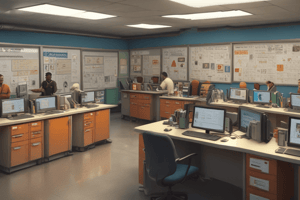Podcast
Questions and Answers
What is the primary responsibility of the Triage Sector?
What is the primary responsibility of the Triage Sector?
- To supervise transportation teams and secure transport modes
- To determine the location, number, and condition of patients (correct)
- To treat patients in accordance with triage protocols
- To extricate patients from the impact area
In the context of a large incident, what does the Treatment Sector prioritize?
In the context of a large incident, what does the Treatment Sector prioritize?
- Establishing communication with extrication teams
- Conducting triage analysis before treatment
- Transporting patients to the hospital as quickly as possible
- Deciding on centralized or separate treatment areas (correct)
Which sector is primarily responsible for notifying Command once all patients have been removed from the impact area?
Which sector is primarily responsible for notifying Command once all patients have been removed from the impact area?
- Transportation Sector
- Extrication Sector (correct)
- Triage Sector
- Treatment Sector
What does the Transportation Sector focus on during larger incidents?
What does the Transportation Sector focus on during larger incidents?
How does the Extrication Sector coordinate with the Triage Sector?
How does the Extrication Sector coordinate with the Triage Sector?
What is a significant consideration for staging during an incident?
What is a significant consideration for staging during an incident?
What does the Triage Sector provide to Command upon completion of their duties?
What does the Triage Sector provide to Command upon completion of their duties?
What role does the Treatment Sector have concerning patient status before transport?
What role does the Treatment Sector have concerning patient status before transport?
What primary role does the Triage Sector have in large multi-patient incidents?
What primary role does the Triage Sector have in large multi-patient incidents?
How does the Treatment Sector determine the method of patient care at an incident site?
How does the Treatment Sector determine the method of patient care at an incident site?
What specific responsibility does the Extrication Sector have during an incident?
What specific responsibility does the Extrication Sector have during an incident?
Which of the following describes the function of the Transportation Sector in the context of an incident?
Which of the following describes the function of the Transportation Sector in the context of an incident?
In large incidents, why is a centralized treatment area preferred by the Treatment Sector?
In large incidents, why is a centralized treatment area preferred by the Treatment Sector?
What information must the Triage Sector provide to Command after triage is completed?
What information must the Triage Sector provide to Command after triage is completed?
What does the Extrication Sector coordinate with Triage to determine?
What does the Extrication Sector coordinate with Triage to determine?
During an incident, which scenario could lead to the designation of separate 'IMMEDIATE' and 'DELAYED' treatment areas?
During an incident, which scenario could lead to the designation of separate 'IMMEDIATE' and 'DELAYED' treatment areas?
What is one function of the Extrication Sector in conjunction with Triage?
What is one function of the Extrication Sector in conjunction with Triage?
How does the Treatment Sector enhance patient care during large incidents?
How does the Treatment Sector enhance patient care during large incidents?
What is a primary concern when establishing the Staging Sector?
What is a primary concern when establishing the Staging Sector?
In what scenario would the Treatment Sector consider separate 'IMMEDIATE' and 'DELAYED' treatment areas?
In what scenario would the Treatment Sector consider separate 'IMMEDIATE' and 'DELAYED' treatment areas?
Which statement accurately reflects the responsibilities of the Triage Sector?
Which statement accurately reflects the responsibilities of the Triage Sector?
What is involved in the role of the Transportation Sector during an incident?
What is involved in the role of the Transportation Sector during an incident?
Which tasks does the Treatment Sector perform after designating a treatment area?
Which tasks does the Treatment Sector perform after designating a treatment area?
What happens to minor patients directed to an Assembly Area by triage teams?
What happens to minor patients directed to an Assembly Area by triage teams?
Flashcards are hidden until you start studying
Study Notes
Basic Sectors in Incident Management
-
Patient Triage is essential for determining the location, number, and condition of patients during incidents, coordinating closely with the Extrication Sector.
-
Triage Sector Responsibilities:
- Assigns and supervises triage teams.
- Ensures adherence to standard operating procedures for patient triage.
- Provides a “Triage Report” to Command upon completion.
- Forwards triage tracking slips to Command.
-
Extrication Sector Purpose:
- Works with Triage to ascertain the details of patients requiring extrication.
- Assigns and supervises extrication teams.
- Ensures safe extrication and delivery of patients to the Treatment Area.
- Notifies Command upon complete removal of all patients from the impact area.
- Minor patients directed to an Assembly Area by triage teams are assessed and delivered for further medical care as needed.
-
Treatment Sector Overview:
- Determines if patient treatment will occur on-site or in a designated treatment area.
- Centralized treatment areas are preferred for efficiency and enhanced patient care.
- In large incidents, may establish separate "IMMEDIATE" and "DELAYED" treatment areas.
- Responsible for assigning and supervising treatment teams, ensuring comprehensive assessment and treatment of all patients.
- Coordinates patient allocation with Transportation Sector and informs Command after patient treatment completion.
-
Transportation Sector Functions:
- Organizes all transportation modes for transferring patients to hospitals.
- Coordinates with Command to establish staging areas, loading zones, and helicopter landing sites.
- Checks hospital availability through the Dispatch Center and synchronizes patient allocation with Treatment Sector.
- Supervises the transfer of patients from treatment to transport areas and notifies hospitals upon ambulances’ or rescues’ arrival.
- Responsible for removing tracking slips from triage tags pre-transport and notifying Command when all Immediate patients have been transported, fulfilling an EMS Tactical benchmark.
- Maintains accurate records of all patients during the transport process.
Basic Sectors in Incident Management
-
Patient Triage is essential for determining the location, number, and condition of patients during incidents, coordinating closely with the Extrication Sector.
-
Triage Sector Responsibilities:
- Assigns and supervises triage teams.
- Ensures adherence to standard operating procedures for patient triage.
- Provides a “Triage Report” to Command upon completion.
- Forwards triage tracking slips to Command.
-
Extrication Sector Purpose:
- Works with Triage to ascertain the details of patients requiring extrication.
- Assigns and supervises extrication teams.
- Ensures safe extrication and delivery of patients to the Treatment Area.
- Notifies Command upon complete removal of all patients from the impact area.
- Minor patients directed to an Assembly Area by triage teams are assessed and delivered for further medical care as needed.
-
Treatment Sector Overview:
- Determines if patient treatment will occur on-site or in a designated treatment area.
- Centralized treatment areas are preferred for efficiency and enhanced patient care.
- In large incidents, may establish separate "IMMEDIATE" and "DELAYED" treatment areas.
- Responsible for assigning and supervising treatment teams, ensuring comprehensive assessment and treatment of all patients.
- Coordinates patient allocation with Transportation Sector and informs Command after patient treatment completion.
-
Transportation Sector Functions:
- Organizes all transportation modes for transferring patients to hospitals.
- Coordinates with Command to establish staging areas, loading zones, and helicopter landing sites.
- Checks hospital availability through the Dispatch Center and synchronizes patient allocation with Treatment Sector.
- Supervises the transfer of patients from treatment to transport areas and notifies hospitals upon ambulances’ or rescues’ arrival.
- Responsible for removing tracking slips from triage tags pre-transport and notifying Command when all Immediate patients have been transported, fulfilling an EMS Tactical benchmark.
- Maintains accurate records of all patients during the transport process.
Basic Sectors in Incident Management
-
Patient Triage is essential for determining the location, number, and condition of patients during incidents, coordinating closely with the Extrication Sector.
-
Triage Sector Responsibilities:
- Assigns and supervises triage teams.
- Ensures adherence to standard operating procedures for patient triage.
- Provides a “Triage Report” to Command upon completion.
- Forwards triage tracking slips to Command.
-
Extrication Sector Purpose:
- Works with Triage to ascertain the details of patients requiring extrication.
- Assigns and supervises extrication teams.
- Ensures safe extrication and delivery of patients to the Treatment Area.
- Notifies Command upon complete removal of all patients from the impact area.
- Minor patients directed to an Assembly Area by triage teams are assessed and delivered for further medical care as needed.
-
Treatment Sector Overview:
- Determines if patient treatment will occur on-site or in a designated treatment area.
- Centralized treatment areas are preferred for efficiency and enhanced patient care.
- In large incidents, may establish separate "IMMEDIATE" and "DELAYED" treatment areas.
- Responsible for assigning and supervising treatment teams, ensuring comprehensive assessment and treatment of all patients.
- Coordinates patient allocation with Transportation Sector and informs Command after patient treatment completion.
-
Transportation Sector Functions:
- Organizes all transportation modes for transferring patients to hospitals.
- Coordinates with Command to establish staging areas, loading zones, and helicopter landing sites.
- Checks hospital availability through the Dispatch Center and synchronizes patient allocation with Treatment Sector.
- Supervises the transfer of patients from treatment to transport areas and notifies hospitals upon ambulances’ or rescues’ arrival.
- Responsible for removing tracking slips from triage tags pre-transport and notifying Command when all Immediate patients have been transported, fulfilling an EMS Tactical benchmark.
- Maintains accurate records of all patients during the transport process.
Studying That Suits You
Use AI to generate personalized quizzes and flashcards to suit your learning preferences.





